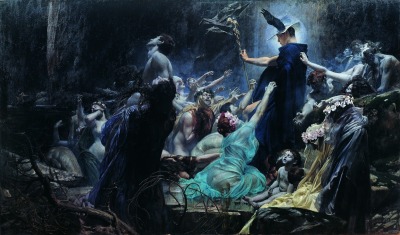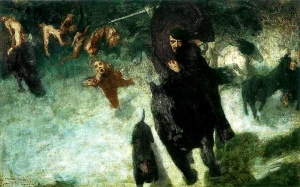 |
| Vienna – 1900 |
 |
| Adolf Hitler |
 |
| Theodor Herzl |
Vienna sheltered both Theodor Herzl — the founder of Zionism — as well as Adolf Hitler, the founder of National Socialism.
 |
| Friedrich Wilhelm Nietzsche |
Friedrich Wilhelm Nietzsche (15 October 1844 – 25 August 1900) was a German philosopher, poet, composer, cultural critic, and classical philologist. He wrote critical texts on religion, morality, contemporary culture, philosophy, and science, displaying a fondness for metaphor, irony, and aphorism.
Nietzsche’s key ideas include the “death of God,” the Übermensch, the eternal recurrence, the Apollonian and Dionysian dichotomy, perspectivism, and the will to power. Central to his philosophy is the idea of “life-affirmation”, which involves questioning of all doctrines that drain life’s expansive energies, however socially prevalent those views might be. His influence remains substantial within philosophy, notably in existentialism, post-modernism, and post-structuralism, as well as outside it. His radical questioning of the value and objectivity of truth has been the focus of extensive commentary, especially in the continental tradition.
human society under the guidance of exceptional leaders.
 |
| Fin de Siecle illustration for ‘Das Rheingold‘ |
 |
| Richard Wagner |
Richard Wagner answered the call, and became the archetype of ‘die neue Kunst’ – ‘the new art’ – the embodiment of the Dionysian ideal for which Nietzsche yearned.
Wilhelm Richard Wagner (22 May 1813 – 13 February 1883) was a German composer, theatre director, polemicist, and conductor who is primarily known for his operas (or, as some of his later works were later known, “music dramas”).
 |
| Parsifal und die Blumenmädchen |
Unlike most opera composers, Wagner wrote both the libretto and the music for each of his stage works. Initially establishing his reputation as a composer of works in the romantic vein of Weber and Meyerbeer,
Wagner revolutionised opera through his concept of the ‘Gesamtkunstwerk’ (“total work of art”), by which he sought to synthesise the poetic, visual, musical and dramatic arts, with music subsidiary to drama, and which was announced in a series of essays between 1849 and 1852.
Wagner realised these ideas most fully in the first half of the four-opera cycle Der Ring des Nibelungen (The Ring of the Nibelung) and his last work – ‘Parsifal’.
 |
| The Austro-Hungarian Empire 1910 |
The Empire had been disintegrating – though few realised this slow decline – internally for many years.
 |
| © Copyright Peter Crawford 2013 |
 |
| Ringstraße – Wien |
The Ringstraße is a circular road surrounding the Innere Stadt district of Vienna, Austria. It is typical of the historical style called Ringstraßenstil (Ringstraße Style) of the 1860s to 1890s. The Ringstraße and the planned buildings were intended to be a showcase for the grandeur and glory of the Habsburg Empire. Sigmund Freud was known to take a daily recreational walk around the Ring.
 |
| ‘Abundantia – The Gifts of the Sea’ – Hans Makart |
Hans Makart (May 28, 1840 – October 3, 1884) was a 19th-century Austrian academic history painter, designer, and decorator; most well known for his influence on Gustav Klimt and other Austrian artists, but in his own era considered an important artist himself and was a celebrity figure in the high culture of Vienna, attended with almost cult-like adulation.
 |
| ‘Junge mit einer Flöte’ Hans Makart |
 |
| Hans Makart |
The “Makartstil”, which determined the culture of an entire era in Vienna, was an aestheticism the likes of which hadn’t been seen before him and has not been replicated to this day. Called the “magician of colors“, he painted in brilliant colors and fluid forms, which placed the design and the aesthetic of the work before all else. Often to heighten the strength of his colors he introduced asphalt into his paint, which has led to some deterioration in his paintings over the years. The paintings were usually large-scale and theatrical productions of historical motifs. Works such as The Papal Election reveal Makart’s skill in the bold use of color to convey drama as well as his later developed virtuoso draughtsmanship.
Makart was deeply interested in the interaction of all the visual arts and thus in the implementation of the idea of the “total work of art” which dominated discussions on the arts in the 19th century. This was the ideal which he realised in magnificent festivities which he organised and centred around himself. The 1879 Makart-parade was the culmination of these endeavors. Makart was also a friend of the composer Richard Wagner, and it can be argued that the two developed the same concepts and stylistic tendencies in their differing art forms: a concern for embedding motifs of history and mythology in a framework of aestheticism, making their respective works historical pageants.
 |
| Sigmund Freud |
In contrast, the avant-garde culture that developed in Vienna over the first two decades of the twentieth century sought to strip away pretence and to probe beneath society’s ‘acceptable’ surface.
Ideas of supposed ‘honesty’ and ‘naturalness’ informed the architecture and theories of Adolf Loos (see below), the satirical journalism of Karl Kraus, and the paintings and graphic work of artists such as Egon Schiele and Richard Gerstl.
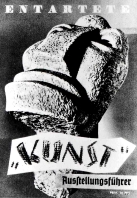 |
| Entartete Kunst |
Expressionism was a modernist movement, initially in poetry and painting, originating in Germany at the beginning of the 20th century. Its typical trait is to present the world solely from a subjective perspective, distorting it radically for emotional effect in order to evoke moods or ideas. Expressionist artists sought to express meaning or emotional experience rather than physical reality.
Expressionism was developed as an avant-garde style before the First World War. It remained popular during the Weimar Republic, particularly in Berlin. The style extended to a wide range of the arts, including painting, literature, theatre, dance, film, architecture and music.
Expressionism is associated with Entartete Kunst as defined in conservative cultural circles, and by Völkisch and National Socialist aesthetics.
 |
| Michaelerplatz Haus – Adolf Loos |
 |
| Adolf Loos |
Adolf Franz Karl Viktor Maria Loos (10 December 1870 – 23 August 1933) was an Austrian architect. He was influential in European Modern architecture, and in his essay Ornament und Verbrechen’ – (Ornament and Crime) he abandoned the aesthetic principles of the Vienna Secession. In this and many other essays he contributed to the elaboration of a body of theory and criticism later referred to as ‘Modernism’ .
Loos authored several polemical works. In ‘Gesprochene in die Leere’ – (Spoken into the Void), published in 1900, Loos attacked the Vienna Secession, at a time when the movement was at its height.
In his essays, Loos used provocative catchphrases, and has become noted for one particular essay/manifesto entitled ‘Ornament and Crime’ – 1910.
 |
| Table Adolf Loos |
 |
| Decorative Consloe Adolf Loos |
In this essay, he explored the idea that the progress of culture is associated with the deletion (?) of ornament from everyday objects, and that it was therefore a crime to force craftsmen or builders to waste their time on ornamentation that served to hasten the time when an object would become obsolete. Loos’ stripped-down buildings influenced the minimal massing of modern architecture, and stirred controversy.
Perhaps surprisingly, some of Loos’s own architectural work was elaborately decorated, although more often inside than outside, and the ornamented interiors frequently featured abstract planes and shapes composed of richly figured materials, such as marble and exotic woods. The visual distinction is not between complicated and simple, but between “organic” and superfluous decoration.
Loos was also interested in the decorative arts, collecting sterling silver and high quality leather goods, which he noted for their plain yet luxurious appeal. He also enjoyed fashion and men’s clothing, designing the famed Kníže of Vienna, a haberdashery.
 |
| Ludwig Wittgenstein |
 |
| Haus Wittgenstein |
Perhaps the most extreme example of this stripped-down approach was the house designed by the philosopher Ludwig Wittgenstein in 1929, but informed by ideas developed before the war.
Haus Wittgenstein is a house in the modernist style designed and built on the Kundmanngasse, Vienna, by the Austrian architect Paul Engelmann and the Austrian philosopher Ludwig Wittgenstein.
 |
| Wittgenstein and Hitler |
In November 1925, Wittgenstein’s sister Margaret Stonborough-Wittgenstein commissioned Engelmann to design and build a large townhouse. Engelmann designed a spare modernist house after the style of Adolf Loos: three rectangular blocks. Wittgenstein showed a great interest in the project and in Engelmann’s plans, and poured himself into the project for over two years. He focused on the windows, doors, door knobs, and radiators, demanding that every detail be exactly as he specified.
Ludwig Josef Johann Wittgenstein (26 April 1889 – 29 April 1951) was an Austrian philosopher who worked primarily in logic, the philosophy of mathematics, the philosophy of mind, and the philosophy of language. Witgenstein, as a boy, went to school with Adolf Hitler – who was also interested in architecture.
 |
| Rudolf Ritter von Alt |
 |
| Der Stephansdom vom Stock im Eisenplatz Rudolf Ritter von Alt |
Rudolf Ritter von Alt (28 August 1812 in Vienna – 12 March 1905 in Vienna) was an Austrian landscape and architectural painter. Born as Rudolf Alt, he could call himself von Alt and bear the title of a Ritter after he gained nobility in 1889.
He was the son of the famous lithographer Jakob Alt (1789–1872). He studied at the Akademie der bildenden Künste in Vienna. Hiking-trips through the Austrian Alps and northern Italy awoke a love for landscapes, and he painted with his brush using watercolors in a very realistic and detailed style. In 1833, inspired by a visit to Venice and neighbouring cities, he also made a number of architectural paintings.
 |
| Ver Sacrum |
Its official magazine was called “Ver Sacrum”.
Ver Sacrum (“Sacred Spring” in Latin) was the official magazine of the Vienna Secession. Published from 1898 to 1903, it featured drawings and designs in the Jugendstil style along with literary contributions from distinguished writers from across Europe. These included Rainer Maria Rilke, Hugo von Hofmannsthal, Maurice Maeterlinck, Knut Hamsun, Otto Julius Bierbaum, Richard Dehmel, Ricarda Huch, Conrad Ferdinand Meyer, Josef Maria Auchentaller and Arno Holz.
 |
| Gustav Klimt |
Gustav Klimt (July 14, 1862 – February 6, 1918) was an Austrian symbolist painter and one of the most prominent members of the Vienna Secession movement. Klimt is noted for his paintings, murals, sketches, and other objets d’art. Klimt’s primary subject was the female body; his works are marked by a frank eroticism.
 |
| Pallas Athena – Gustav Klimt |
He remained with the Secession until 1908. The group declared no manifesto and did not set out to encourage any particular style—Naturalists, Realists, and Symbolists all coexisted. The government supported their efforts and gave them a lease on public land to erect an exhibition hall. The group’s symbol was Pallas Athena, the Greek goddess of just causes, wisdom, and the arts—of whom Klimt painted his radical version in 1898.
 |
| Allegory of Sculpture – Gustav Klimpt |
Klimt had transformed traditional allegory and symbolism into a new language that was more overtly sexual and hence more disturbing to some. The public outcry came from all quarters—political, aesthetic and religious. As a result, the paintings were not displayed on the ceiling of the Great Hall. This would be the last public commission accepted by the artist.
 |
| Otto Wagner |
Otto Koloman Wagner (* July 13 1841 in Penzing in Vienna , † 11 April 1918 in Vienna 7 ) was the most important Austrian architect , architectural theorist and urban planner Vienna in the Belle Epoque or at the fin de siècle. His Art Nouveau , his academic work and his writings on urban planning in the 1890s helped him to worldwide recognition.
 |
| Beethoven – Max Klinger |
The Secession artists objected to the prevailing conservatism of the Vienna Künstlerhaus, with its traditional orientation toward Historicism.
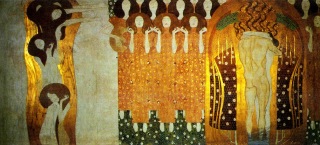 |
| Beethoven Frieze – Gustav Klimpt |
Max Klinger (February 18, 1857 – July 5, 1920) was a German Symbolist painter, sculptor, printmaker, and writer.
Klinger was born in Leipzig and studied in Karlsruhe. An admirer of the etchings of Menzel and Goya, he shortly became a skilled and imaginative engraver in his own right. He began creating sculptures in the early 1880s. From 1883-1893 he lived in Rome, and became increasingly influenced by the Italian Renaissance and antiquity. Klinger was cited by many as being a major link between the Symbolist movement of the 19th century and the start of the metaphysical and Surrealist movements of the 20th century.
 |
| Vienna Secession Building Joseph Maria Olbrich |
The Vienna Secession building, was built in 1898 by Joseph Maria Olbrich, in the Jugendstil style as a showcase for the Secession movement’s artists .
The building has been adapted and renovated several times:
 |
| Vienna Secession Building Joseph Maria Olbrich |
The entrance hall was altered in 1901. In 1908, part of the ornamentation and the slogan “Der Zeit ihre Kunst. Der Kunst ihre Freiheit” (“For every time its art. For art its Freedom”) were removed.
Its best-known exhibit is Gustav Klimt famous Beethoven Frieze – a monumetal wall cycle – designed in 1902.
This exhibition, conceived as an homage to the composer Ludwig van Beethoven, most sublimely embodied the secessionist idea of the gesamtkunstwerk – a comprehensive work of art.
 |
| Haus Feinhals – Marienburg – Joseph Olbrich |
 |
| Joseph Maria Olbrich |
Joseph Maria Olbrich (22 December 1867 – 8 August 1908) was an Austrian architect and co-founder of the Vienna Secession.
Olbrich was born in Opava, Austrian Silesia. He was the third child of Edmund and Aloisia Olbrich.
Olbrich studied architecture at the University of Applied Arts Vienna (Wiener Staatsgewerbeschule) and the Academy of Fine Arts Vienna, where he won several prizes.
 |
| Ernst Ludwig House – Darmstadt – Joseph Maria Olbrich |
In 1893, he started working for Otto Wagner, the Austrian architect, and probably did the detailed construction for most of Wagner’s Wiener Stadtbahn buildings.
In 1897, Gustav Klimt, Olbrich, Josef Hoffmann and Koloman Moser founded the Vienna Secession artistic group. Olbrich designed their exhibition building, the famous Secession Hall, which became the movement’s landmark.
Olbrich executed diverse architectural commissions and experimented in applied arts and design. He designed pottery, furniture, book bindings, and musical instruments. His architectural works, especially his exhibition buildings for the Vienna and Darmstadt Secessions, had a strong influence on the development of the Art Nouveau style.
Olbrich died from leukemia in Düsseldorf on August 8, aged 40.
 |
| Paul Bürck – Male Nude |
 |
| Paul Bürck – Mythological Scene |
The Ernst Ludwig House – The laying of the foundation stone took place on the 24th of March 1900. The atelier was both a worksite and the venue for gatherings in the artists’ colony. In the middle of the main floor is the meeting room with paintings by Paul Bürck and there are three artist studios to each side of it. There are two underground artists’ apartments and underground rooms for business purposes. The entrance is located in a niche that is decorated with gold-plated flower motifs. Two six-metre tall statues, “Man and Woman” or “Strength and Beauty”, flank the entrance and are the work of Ludwig Habich.
 |
| ‘Betender Knabe’ Ludwig Habich |
 |
| ‘Grabenkmal as einer Gafallen’ Ludwig Habich |
Paul Wilhelm Bürck (* September 3rd 1878 in Strasbourg , † April 18 1947 in Munich ) was a German painter, graphic artist and textile designer and worked as a member of the Darmstadt artists’ colony on the Mathildenhoehe.
Ludwig Habich (* April 2 1872 in Darmstadt , † January 20th 1949 in Jugenheim ) was a German sculptor and medalist .Habich created sculptures for Darmstadt, including the colossal figures of a man and a woman at the entrance to the Ernst-Ludwig House.
 |
| xiii secession – 1902 |
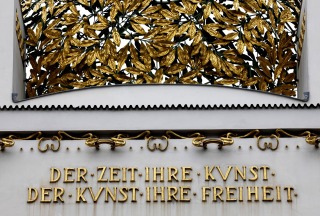 |
| “Der Zeit ihre Kunst. Der Kunst ihre Freiheit.” |
The Secession building could be considered the icon of the movement.
 |
| Karlsplatz Stadtbahn – Otto Wagner |
Secessionist architects often decorated the surface of their buildings with linear ornamentation.
 |
| ‘Der Arbend ‘ 1882 – Max Klinger |
 |
| ‘Triton und Nereide’ – Max Klinger |
Max Klinger (February 18, 1857 – July 5, 1920) was a German Symbolist painter, sculptor, printmaker, and writer. Klinger was born in Leipzig and studied in Karlsruhe. An admirer of the etchings of Menzel, he shortly became a skilled and imaginative engraver in his own right. He began creating sculptures in the early 1880s. From 1883-1893 he lived in Rome, and became increasingly influenced by the Italian Renaissance and antiquity.
Klinger traveled extensively around the art centres of Europe for years before returning to Leipzig in 1893. From 1897 he mostly concentrated on sculpture; his marble statue of Beethoven was an integral part of the Vienna Secession exhibit of 1902. (see ‘GALLERY’ below for more of Klinger’s works)
 |
| ‘Die Toteninsel’ – Arnold Böcklin |
Arnold Böcklin (16 October 1827 – 16 January 1901) was a symbolist painter, and one of Adolf Hitler’s favourite artists.
Influenced by Romanticism his painting is symbolist with mythological subjects often overlapping with the English Pre-Raphaelites.
 |
| Selbstporträt mit fiedelndem Tod Arnold Böcklin |
His pictures portray mythological, fantastical figures along classical architecture constructions (often revealing an obsession with death) creating a strange, fantasy world.
Böcklin is best known for his five versions (painted in 1880-1886) of ‘ Die Toteninsel’ (Isle of the Dead).
In 1933, the painting was put up for sale, and a noted Böcklin admirer, Adolf Hitler, acquired it. He hung it first at the Berghof in Obersalzberg and, then after 1940, in the New Reich Chancellery in Berlin.
Böcklin’s work is one of the most consummate expressions of all that was later disliked about the latter half of the nineteenth century.
(see ‘GALLERY’ below for more of Böcklin’s works)
 |
| Majolikahaus – Otto Wagner |
The so-called Majolica in the left Vienna Line 40 was built in 1898. The facade is decorated with glazed majolica tiles of the company Wienerberger dressed, decorated with floral motifs. These ceramic tiles are weather resistant, easy to clean and washable – for Otto Wagner hygiene was an important part of modernity. .
 |
| Wiener Werkstätte |
Established in 1903, the Wiener Werkstätte was a production community of visual artists in Vienna, Austria bringing together architects, artists and designers.
 |
| Josef Hoffmann – Chair |
 |
| Moser – Zebra Cabinet – 1904 |
The range of product lines also included; leather goods, enamel, jewellery, postcards and ceramics. The Wiener Werkstätte even had a millinery department.
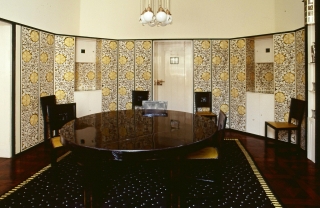 |
| Palais Stoclet – Josef Hoffmann |
Several branches of the workshop were opened in Karlsbad 1909, Marienbad, Zürich 1916/17, New York 1922, Berlin 1929.
The Stoclet Palace (French: Palais Stoclet, Dutch: Stocletpaleis) is a private mansion built by architect Josef Hoffmann between 1905 and 1911 in Brussels, Belgium, for banker and art lover Adolphe Stoclet. Considered Hoffman’s masterpiece, the Stoclet’s house is one of the most refined and luxurious private houses of the twentieth century.
 |
| Josef Hoffmann |
 |
| Sessel Kubus – Josef Hoffmann |
Josef Hoffmann (December 15, 1870 – May 7, 1956) was an Austrian architect and designer of consumer goods. Together with Joseph Maria Olbrich they founded the Vienna Secession in 1897 along with artists Gustav Klimt, and Koloman Moser.
Beginning in 1899, he taught at the University of Applied Arts Vienna. With the Secession, Hoffmann developed strong connections with other artists. He designed installation spaces for Secession exhibitions and a house for Moser which was built from 1901-1903. However, he soon left the Secession in 1905 along with other stylist artists due to conflicts with realist naturalists over differences in artistic vision and disagreement over the premise of Gesamtkunstwerk. With the banker Fritz Wärndorfer and the artist Koloman Moser he established the Wiener Werkstätte, which was to last until 1932. He designed many products for the Wiener Werkstätte.
 |
| Kolo Moser – ‘Selbstbildnis’ |
 |
| ‘Allegorie des Frühlings’ Koloman Moser |
Koloman Moser (March 30, 1868 – October 18, 1918) was an Austrian artist who exerted considerable influence on twentieth-century graphic art, and one of the foremost artists of the Vienna Secession movement and a co-founder of Wiener Werkstätte.
During his life, Moser designed a wide array of art works – books and graphic works from postage stamps to magazine vignettes; fashion; stained glass windows, porcelains and ceramics, blown glass, tableware, silver, jewelry, and furniture – to name a few of his interests.
And in the same year Moser, embittered by the financial squabbling, left the Wiener Werkstätte, which subsequently entered a new phase, both stylistically and economically.
 |
| Berlin 1900 |
By the turn of the century, Berlin had become an industrial city with 800,000 inhabitants.
Improvements to the infrastructure were needed; in 1896 the construction of the subway (U-Bahn) began and was completed in 1902.
The neighborhoods around the city center (including Kreuzberg, Prenzlauer Berg, Friedrichshain and Wedding) were filled with tenement blocks.
 |
| ‘Schauspielhaus’ – Berlin |
The surroundings saw extensive development of industrial areas East of Berlin and wealthy residential areas in the South-West.
In terms of high culture, museums were being built and enlarged, and Berlin was on the verge of becoming a major musical city.
Berlin dominated the German theater scene, with the government-supported Opernhaus and Schauspielhaus, as well as numerous private playhouses included the Lessing and the Deutsches theatres.
 |
| ‘Verein Berliner Künstler’ |
The Berlin Secession was an art association founded by Berlin artists in 1898 as an alternative to the conservative state-run ‘Verein Berliner Künstler’ (Association of Berlin Artists).
That year the official salon jury rejected a landscape by Walter Leistikow, who was a key figure among a group of young artists interested in modern developments in art.
Sixty-five young artists formed the initial membership of the Secession.
Max Liebermann was the Berlin Secession’s first president, and he proposed to the Secession that Paul Cassirer and his cousin Bruno act as business managers.
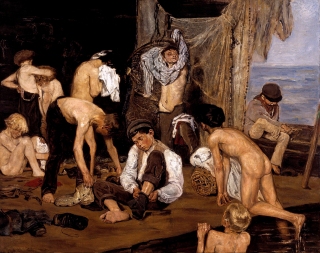 |
| ‘Im Schwimmbad’ – Max Liebermann |
Max Liebermann (July 20, 1847 – February 8, 1935) was a German painter and printmaker, and one of the leading proponents of Impressionism in Germany.
He used his own inherited wealth to assemble an impressive collection of French Impressionist works. He later chose scenes of the bourgeoisie, as well as aspects of his garden near Lake Wannsee, as motifs for his paintings. In Berlin, he became a famous painter of portraits; his work is especially close in spirit to Édouard Manet.
From 1899 to 1911 he led the premier avant-garde formation in Germany, the Berlin Secession. Beginning in 1920 he was president of the Prussian Academy of Arts..
Together with Lovis Corinth and Max Slevogt, Liebermann became an exponent of German Impressionism.
In 1901 Bruno Cassirer resigned from the Secession, so that he could dedicate himself entirely to the Cassirer publishing firm.
Paul took over the running of the Cassirer gallery, and supported various Secessionist artists including the sculptors Ernst Barlach and August Gaul.
Notable members of the Secession included: Max Beckmann, Lovis Corinth, Lyonel Feininger, Georg Kolbe, Käthe Kollwitz, Julie Wolfthorn, Hermann Struck, Adolf Eduard Herstein, Ludwig Dettmann and Max Slevogt
 |
| Selbstporträt – Lovis Corinth |
 |
| ‘Gekreuzigt Dieb’ Lovis Corinth |
Lovis Corinth (21 July 1858 – 17 July 1925) was a German painter and printmaker whose mature work realized a synthesis of impressionism and expressionism.
Corinth studied in Paris and Munich, joined the Berlin Secession group, later succeeding Max Liebermann as the group’s president.
His early work was naturalistic in approach. Corinth was initially antagonistic towards the expressionist movement, but after 1911 his style loosened and took on many expressionistic qualities.
His use of color became more vibrant, and he created portraits and landscapes of extraordinary vitality and power. Corinth’s subject matter also included nudes and biblical scenes.
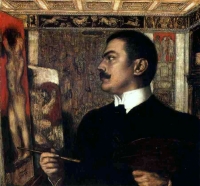 |
| Franz Ritter von Stuck |
 |
| Glaspalast – München |
The Münchner Sezession grew out of a dispute between the Munich ‘Künstlergenossenschaft’ with the ‘Allgemeine Deutsche Kunstgenossenschaft’ in 1893.
The Münchner Sezession is the earliest schism of a group of artists in protest against an existing artists’ association, but other Secessions followed in Vienna, Berlin (see above).
 |
| Münchner Sezession |
The first Münchner Sezession catalogue was issued on 15 July 1893.
At that time some Berlin artists, both sculptors and painters, belonged to the Münchner Sezession out of which the Berliner Secession would grow in 1899.
Like the Wiener and Berliner Secessions, the Münchner Secession embraced all the various art forms,including fine art (painting and sculpture), architecture, graphic art, and industrial art (furniture, interior decoration etc.)
Prominent German artists included Paul Hoecker (1854-1910), Leopold von Kalckreuth (1855-1928), Christian Landenberger (1862-1927), Max Liebermann (1847-1935), Hans Olde (1855-1917), Franz von Stuck (1863-1928) and the architect Peter Behrens (1868-1940).
 |
| Villa Stuck – München – 1897-98 |
In 1897 began work designing his own residence and studio, the Villa Stuck. His designs for the villa included everything from layout to interior decorations and furniture.
Stuck’s subject matter was primarily from mythology, inspired by the work of Arnold Böcklin. Large forms dominate most of his paintings and indicate his proclivities for sculpture. His seductive female nudes are a prime example of popular Symbolist content. Stuck paid much attention to the frames for his paintings and generally designed them himself with such careful use of panels, gilt carving and inscriptions that the frames must be considered as an integral part of the overall piece.
 |
| Peter Behrens |
 |
| AEG Turbine Factory – Peter Behrens |
Peter Behrens (14 April 1868 – 27 February 1940) was a German architect and designer. He was important for the modernist movement.
He was one of the leaders of architectural change at the turn of the century and was a major designer of factories and office buildings in brick, steel and glass.
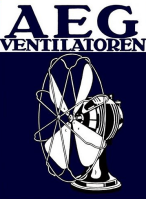 |
| AEG Poster |
In 1903, Behrens was named director of the Kunstgewerbeschule in Düsseldorf, where he implemented reforms. In 1907, Behrens and ten other people (Hermann Muthesius, Theodor Fischer, Josef Hoffmann, Joseph Maria Olbrich, Bruno Paul, Richard Riemerschmid, Fritz Schumacher, among others), plus twelve companies, gathered to create the Deutscher Werkbund As an organization, it was clearly indebted to the principles and priorities of the Arts and Crafts movement, but with a decidedly modern twist. Members of the Werkbund were focused on improving the overall level of taste in Germany by improving the design of everyday objects and products. This very practical aspect made it an extremely influential organization among industrialists, public policy experts, designers, investors, critics and academics. Behrens’ work for AEG was the first large-scale demonstration of the viability and vitality of the Werkbund’s initiatives and objectives.
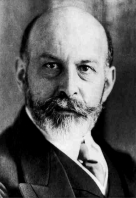 |
| Hermann Muthesius |
 |
| Deutscher Werkbund |
The Deutscher Werkbund (German Work Federation) was a German association of artists, architects, designers, and industrialists.
 |
| ‘Festspielhaus Hellerau’ – Dresden – Heinrich Tessenow |
 |
| Heinrich Tessenow |
‘Die Seelen am Acheron’
Adolf Hirémy-Hirschl
‘Ahasver am Ende der Welt’
Adolf Hirémy-Hirschl
Influenced by Romanticism his painting is symbolist with mythological subjects often overlapping with the English Pre-Raphaelites.
His pictures portray mythological, fantastical figures along classical architecture constructions (often revealing an obsession with death) creating a strange, fantasy world.
Böcklin is best known for his five versions (painted in 1880-1886) of ‘ Die Toteninsel’ (Isle of the Dead).
In 1933, the painting was put up for sale, and a noted Böcklin admirer, Adolf Hitler, acquired it. He hung it first at the Berghof in Obersalzberg and, then after 1940, in the New Reich Chancellery in Berlin.
Böcklin’s work is one of the most consummate expressions of all that was later disliked about the latter half of the nineteenth century.
MÜNCHNER SECESSION











